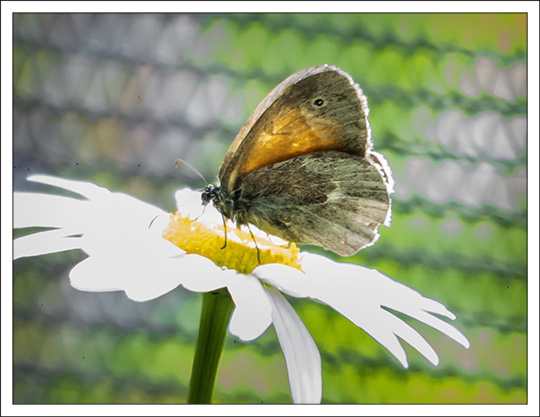Butterflies of the Adirondack Mountains:
Common Ringlet (Coenonympha tullia)
 Butterflies of the Adirondacks: Common Ringlet in the Paul Smiths VIC Butterfly House (25 June 2013)
Butterflies of the Adirondacks: Common Ringlet in the Paul Smiths VIC Butterfly House (25 June 2013)
| This page is no longer being updated. For an updated version of this material, see: Common Ringlet (Coenonympha tullia). |
Identification: The Common Ringlet (Coenonympha tullia) is an orange and brown butterfly that may be seen in the Adirondack Mountains of upstate New York in early summer. It is a member of the Nymphalidae family. [1] The appearance of this butterfly is extremely variable geographically. [2] [3] [4] It is highly variable in both color and the number of eye spots, between and within subspecies and even within local populations. [5] [6] Up to 20 subspecies are recognized in North America. [7] [8]
The ringlets in our area (and in eastern Canada) are generally darker than those in the west; [9] they are usually a grayish brown with orange on the under side of the fore wing. [10] The hind wings are usually darker than the basal part of the fore wings. [11] The under side of the fore wing usually has a small eye spot. [12] [13] [14] The wing span is 1 1/3 to 1/1/2 inches. [15] [16] These insects bounce through the grass, stopping frequently to nectar. [17]
Life History: Male ringlets patrol above the tops of grasses to seek females. [18] The larvae are green, olive or brown. [19] [20] Caterpillars hibernate in thick mats of dead grass. [21] [22] [23] Caterpillar hosts include grasses and rushes. [24] [25] [26] Adult ringlets feed on flower nectar.
Habitat and Range: Common Ringlets make their homes in a wide variety of grassy habitats, including fields, meadows, grasslands, roadsides, woodland edges and clearings, prairies, freshwater swamps, bogs, and tundra. [27] [28] [29] [30] Common Ringlets range throughout northern Europe and Asia. They have extended their range significantly over the last few decades. [31] Their range now extends from coast to coast in Canada and the northern US. [32] [33] This butterfly is widespread and common in the west and north. [34] In the US, the Common Ringlet's range includes New England and the Adirondacks. [35]
Flight: The flight period for the Common Ringlet throughout its range is from May to July in the north and from May to September in the mid-latitudes. [36] [37] This species usually has one flight, with a partial second brood in the southern parts of its range. [38] [39]
The ringlet's flight period in the Adirondack Park has not been established. It is, however, a fairly frequent guest in the Paul Smiths VIC Native Species Butterfly House in early summer. In 2012, The Common Ringlet was recorded as present from the day of the Butterfly House opening (9 June) to 22 June. [40] In 2013, Common Ringlets were present in the Butterfly House in the latter part of June. [41]
References
- Susan Grimm Hanley. Interpretive Naturalist, Paul Smith's College Native Species Butterfly House. Species Logbooks.
- Butterflies and Moths of North American. Species Profiles. Confirmed sightings:6/15/13, 6/25/13
- Government of Canada. Canadian Biodiversity Information Facility. SpeciesBank
- ENature. Field Guides.
- Iowa State University. Department of Entomology. BugGuide.
- Butterflies of America. Coenonympha tullia.
- University of Alberta. Department of Biological Sciences. E.H. Strickland Entomological Museum. Coenonympha tullia.
- Ross A. Layberry, Peter W. Hall, and J. Donald Lafontaine. The Butterflies of Canada (University of Toronto Press, 1998), pp. 215-216, Plate 18.
- Jim P. Brock and Kenn Kaufman. Kaufman Field Guide to Butterflies of North America (Houghton Mifflin, 2003), pp.240-241.
- Paul A. Opler. A Field Guide to Eastern Butterflies (The Peterson Field Guide Series, Houghton Mifflin Company, 1992,1998), pp. 98-99, 303-304.
- James A. Scott. The Butterflies of North America. A Natural History and Field Guide (Stanford University Press, 1986), pp. 239-240.
- Jeffrey Glassberg. Butterflies through Binoculars. The East. A Field Guide to the Butterflies of Eastern North America (Oxford University Press, 1999), p. 138, Plate 44.
- Jeffrey Glassberg. Butterflies through Binoculars. A Field Guide to the Butterflies in the Boston-New York-Washington Region (Oxford University Press, 1993), pp. 67-68, Plate 23.
